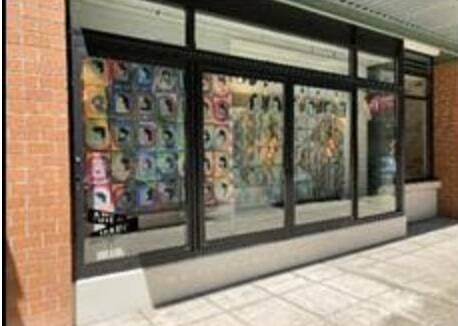From Michael Dinning’s earliest years to today, art has been the primary medium through which he has grappled with the bottomless mystery of human identity.
Starting, as far back as he can remember, with the mystery he presents to himself, he says, manifested in a constant inward examination to find a sense of self he could project to the world.
“It seemed to me that identity doesn’t just happen, it is something created by the people, places and things, both grand and intimate, that we choose to hold close, and that we need to return to, again and again, as we navigate the world around us,” Dinning explained in a statement accompanying his work.
It’s all there in “American Fabric,” Dinning’s art installation on display at Auburn’s Art on Main window-front gallery between July 11 and Oct. 2, 2022, presented by the City of Auburn and the Auburn Arts Commission.
Visitors will see his fascination for personal idiosyncrasies and regional traditions reflected in all the people his work depicts, in images gleaned from cross-country and closer-to-home travels and ongoing romance with “what makes individuals unique, what defines them, and trying to work out how people see me.”
Each individual, Dinning said, develops from a composite of bits and pieces, essential and mundane, which compels that person, brings them joy, and defines how they wish to see themselves and how others see them.
Individuation is a process that goes on and on throughout a person’s lifetime.
And as in the human being, so in the development of nations and cultures.
The USA, Dinning writes, is a collection of individuals and traditions, and to understand how and where a person fits in the world, he writes, it is “important to value the life right around us, our communities of people and events, routines and ideas.”
In his travels, Dinning seeks out the history of the places he visits, considers how people came to belong there and how the character of the people shaped the history of the place and the other way around.
America, Dinning writes, is “a magnet for people seeking a better life, a shelter from misery,” a place where there is hope.
“Immigration is an issue in American society that is fraught with emotion, division and acrimony,” Dinning said. “Instead of rending society with our differences, we can instead focus on the character of a man like Abraham Lincoln. Few people in American history have believed as strongly as Lincoln that the need for human dignity must be at the root of this country. A free and diverse population is what makes America unique in the world, and lies at the strength of our country.
“I believe that when we turn our backs on that diversity, and deny those who believe in America as a place where a better life can be found, it weakens our country, and darkens the light of the American experience and our basic ideals as a people,” Dinning writes.
The gallery is viewable from the street 24 hours a day, 7 days a week
More artists
Dinning’s work is only one sampling of the arts feast the Auburn Arts Commission and the city have spread out for residents and visitors alike to scope out this summer and fall. The artists below will be featured in subsequent articles.
■ Xander Griffith at the Cheryl Sallee Gallery, on view between July 7 and Nov. 3, 2022. According to the city, Griffith creates rich works of art in felt that “pay homage to the cultural heritage and incredible landscape of the Northwest.”
■ Brooke Fotheringham at the Community and Event Center Gallery from July 6 to Nov. 2, 2022. According to the city, Fotheringham creates, “mesmerizing kaleidoscopic artworks,” and experiments in digital photo editing and interests in eco-modernism,” intended to be a visual exploration of the potential of genetic engineering to survive on a rapidly-changing planet.
■ Trenton Quiocho at the City Hall Gallery, on view July 6 to Aug. 30, 2022. This glass artist explores ways to preserve the rich histories, folktales and Filipino traditions that have been lost through colonization. Quiocho said glass provides him opportunity to create “a revitalized, visual language that speaks to this cultural iconography, and through this, breathes new life into the folktales and stories behind them.”


